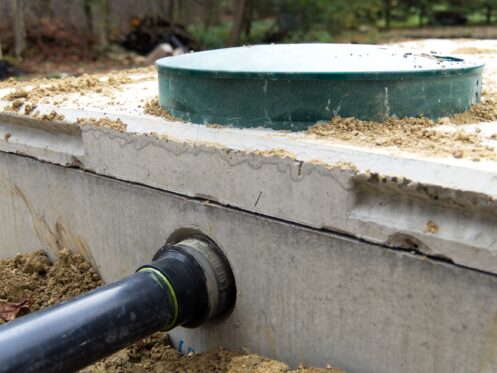The purpose of the chain in a septic system might appear elusive to those unfamiliar with its function. Often overlooked, this unassuming yet essential component is responsible for vital operations within the system. Understanding the significance and role of the chain is fundamental to comprehending the inner workings of septic systems and appreciating their contribution to environmental and public health. In this insightful exploration, we delve into the purpose of this chain. We shed light on its functions, how it interacts with other components, and the pivotal role it plays in ensuring the proper functioning and longevity of the septic system.
What’s the Purpose of the Chain in Your Septic Tank?
The chain in a septic system is commonly called the baffling chain or the scum blanket retention chain. Its primary function is to help maintain the proper separation of waste materials within the septic tank. The septic tank is designed to hold solid waste and separate scum (lighter materials) and sludge (heavier materials) from the liquid effluent. When wastewater enters the septic tank, it undergoes a natural stratification process. The lighter scum, consisting of oils, grease, and other floating debris, rises to the top, forming a layer. Conversely, the heavier sludge settles at the bottom of the tank. In between these layers, the liquid effluent remains.
The chain plays a vital role in preventing the scum layer from floating too close to the outlet pipe, as it could result in the undesired carryover of solids into the drain field. By attaching to the top of the outlet baffle, the chain ensures that the scum layer is kept at an optimal distance from the outlet pipe. It acts as a barrier, preventing any solid or scum material from escaping into the drain field.
In addition to its role in maintaining the separation of waste materials, the chain also serves as an indicator of septic tank health. Over time, scum and sludge accumulate within the tank, reducing its capacity and efficiency. As the level of scum rises, the chain will gradually lower, signaling the need for septic tank maintenance, such as pumping or cleaning.
Why the Chain in Your Septic Tank Keeps Loosening
One of the primary reasons for a loosening chain in a septic tank is corrosion. Over time, the chain may come into contact with corrosive substances present in the tank, such as hydrogen sulfide gas or chemical byproducts. Corrosion weakens the chain, causing it to stretch or break, leading to a loose connection. To mitigate this issue, it is important to ensure that the chain is made of corrosion-resistant materials, such as stainless steel. Regular inspections and maintenance can also help identify and address any signs of corrosion early on.
Septic tank chains are constantly exposed to moisture, waste, and other abrasive elements, which can contribute to wear and tear over time. The continuous movement and pressure exerted on the chain as the septic system operates can also lead to loosening. Additionally, excessive strain or heavy loads on the chain, such as the weight of the pump or agitator, can contribute to its gradual loosening. It is crucial to use high-quality, durable chains specifically designed for septic tank applications and replace them when signs of wear become evident.
In some cases, a loose chain may result from improper installation or adjustment. If the chain is not securely fastened to the components within the septic tank, it can easily become loose over time. Similarly, if the chain is not correctly adjusted to the appropriate tension, it may gradually loosen. It is advisable to consult Cozy Home Services professionals during installation or adjustment to ensure proper alignment and tension of the chain, reducing the likelihood of it coming loose in the future.
What Are the Effects of a Loose Septic Tank Chain?
One of the primary consequences of a loose septic tank chain is reduced drainage efficiency. The chain is responsible for connecting the floating scum layer to the outlet pipe, allowing the separation of solids from the liquid effluent. When the chain is loose, the scum layer might not be properly held in place, leading to inefficient separation. This can result in clogged pipes, slow drainage, and even backflow issues.
Additionally, a loose septic tank chain can pose a significant risk of contamination to the surrounding environment. If the chain fails to maintain a proper seal between the scum layer and the outlet pipe, untreated wastewater may leak into the soil or groundwater. This can contaminate nearby water sources, posing health hazards for both humans and wildlife. Additionally, the foul odor associated with septic tank leaks can be unpleasant and disruptive to the quality of life in the vicinity.
A loose chain can also compromise the integrity of the septic system. As the scum layer is not effectively restrained, it can accumulate in the outlet pipe and cause blockages. This accumulation of solid waste can exert pressure on the tank walls, leading to cracks or other structural damage. Such damage can result in costly repairs or even necessitate the replacement of the entire septic system.
Ultimately, a loose septic tank chain can have far-reaching consequences for the functionality and safety of a septic system. Reduced drainage efficiency, increased contamination risk, and structural damage are just a few of the effects that can arise from neglecting this critical component.
Signs That Your Septic Tank Chain Should Be Replaced
The first sign to watch for is excessive chain slack. If you notice that the chain has become loose and is no longer properly taut, it may have stretched or worn out. A loose chain can disrupt the functioning of the septic system, leading to blockages or improper drainage. Another indicator is frequent clogging or backups in your plumbing system. When the septic tank chain deteriorates, it can hinder the smooth flow of wastewater, causing it to back up into your sinks, toilets, or showers. If you experience recurring clogs despite routine maintenance, it’s time to let our plumbers examine the septic tank chain.
Unpleasant odors in your yard or around the septic tank area can also signify a faulty chain. As the chain weakens, it may allow gases from the septic tank to escape, resulting in foul smells. Odors should never be ignored, as they can indicate a potential septic system failure. Lastly, consider the age of your septic tank and chain. Most septic tanks have a lifespan of about 20 to 30 years, depending on maintenance and usage. If your tank or chain is nearing this range, it’s wise to have our professionals perform an inspection to determine if replacement is necessary. By addressing these issues promptly, you can avoid more significant problems and ensure the smooth functioning of your septic system for years to come. Remember, regular maintenance and professional inspections are essential for the longevity of your septic tank and its components.
Apart from plumbing services, Cozy Home Services also provides HVAC installation services, electrical and solar panel installations, air purification services, and indoor air quality solutions to Vacaville, CA residents. Contact Cozy Home Services today to learn more.



